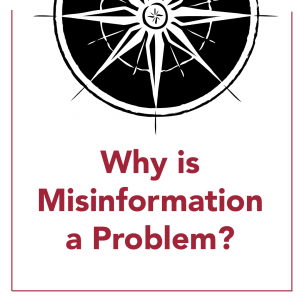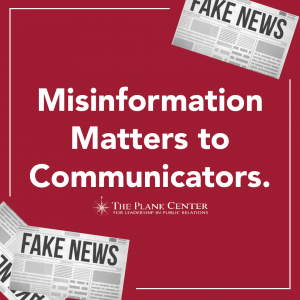Mindfulness: The Answer to the Biggest Threat America Faces Today
Published on April 15, 2021 at 8:38 p.m.
by Lawson Colgate.
Content, not information, distributed to the public with an intentional attempt to mislead is an existential threat to the world today. The Plank Center for Leadership in Public Relations confronted the crisis of misinformation on Thursday, April 15, in a webinar with guests Alan Miller, the founder and CEO of The News Literacy Project, and Elisa Shearer, research associate at Pew Research Center.
The what
Disinformation negatively impacts the way our world works, dividing us and posing a threat to the healthy operations of our society. Public relations practitioners have a role in mindfully helping others differentiate between valid and invalid content.

The choice of terms matters. “Disinformation” speaks to the intention behind the creation and distribution of content that is designed to mislead, inflame and divide. “Misinformation” might fit that same definition, but also can include inaccurate information that results from an honest mistake. When disinformation becomes the belief system of an individual or group, it presents an immediate threat to the country’s public life, society and the ability to trust what we see and hear from institutions and individuals.
“It impacts a lot of different aspects of life in America, and concern about it is very high,” said Shearer. “It ranges from people’s perceptions about current events to something as basic as their trust in government and their trust in each other.”
As noted in the webinar, multiple factors play a role in what human beings believe, as well as how they think about disinformation. Existing attitudes, opinions, personal identity, religious beliefs and political views impact the effectiveness of disinformation on individuals differently — and its creators are exceptionally skilled in pushing precisely honed messages to people most susceptible to a specific idea, theme or image.
Miller, Shearer and Plank Center board member Mark Harris emphasized that disinformation is a bipartisan concern. Whether you are engaged in the news or not, strands of disinformation are often more believed by people who turn to news sources with like-minded audiences. It is perceived as a threat differently depending on the person.
The threat
Even in 2019, Americans ranked disinformation above racism, illegal immigration and terrorism as the country’s biggest problem, according to a Pew Research Center study.
In more recent months, disinformation has negatively impacted the country in terms of COVID-19 and the election. Shearer cited data from a Pew Research Center study, which found that 49% of Americans think disinformation has caused a great deal of confusion about COVID-19. During the 2020 election, 72% of Americans expressed they had seen election news that seemed completely made up, and following it 60% said disinformation had a major outcome on the election.
“The country has gone from alternative facts to alternative realities,” said Miller. Dating back to the beginning of the 2020 year to now, Miller said the last year has been a perfect storm in terms of disinformation — from the source of COVID-19, to the vaccines against it, to the rise of QAnon and pre- and post-election disinformation.
Miller said that facts are at the root of our civic life. They are the basis for what we teach in our schools, for our scientific inquiry and findings, and for our effective public policy debates and decisions. Disinformation poses a threat to a future founded in facts, and that in itself is a problem we must be mindful of and work against.
The answer
The Pew Research Center indicates that although politicians and their staff and activist groups are believed by Americans to create half or over half of disinformation content, 53% think news media is the most responsible for reducing disinformation.
Harris highlighted the important role PR practitioners play in restoring people’s ability to trust what they see and hear.

“It is our responsibility to help the leaders we support and brands we represent overcome the threat of disinformation,” said Harris. “To address the severity of this crisis, we have to understand the sources — call them fabricators — their agendas and the fundamental role of social media.”
The News Literacy Project challenges people to step back and be particularly skeptical by asking, “What am I looking at?” as Miller mentions in the webinar. It is important to analyze every detail of the “information.” Consumers need to seek factual intention behind information, not confirmation of their personally pre-determined beliefs.
Communicators play imperative roles in magnifying the severity of this threat and combating it. In order to encourage consumers to become more mindful, PR practitioners and communicators need to join forces.
The PR profession has a curiosity in the honesty of information. Practitioners must work for change and take positions for what they will and won’t stand for. By educating themselves on news literacy and being knowledgeable and aware of disinformation, they can defeat it head-on and become champions of this effort.
The movement to confront and defeat the spread of disinformation starts with awareness and independent, critical thinking. The more mindful and informed a communications professional is on a personal level, the more effective they can be when helping their company, clients and network identify content that’s credible, and promote healthy news consumption and sharing habits. In the effort to combat disinformation, being mindful will not only benefit the individual, but those around them as well.




